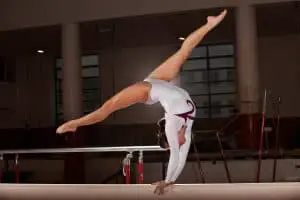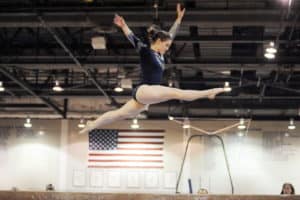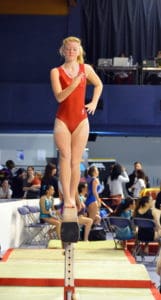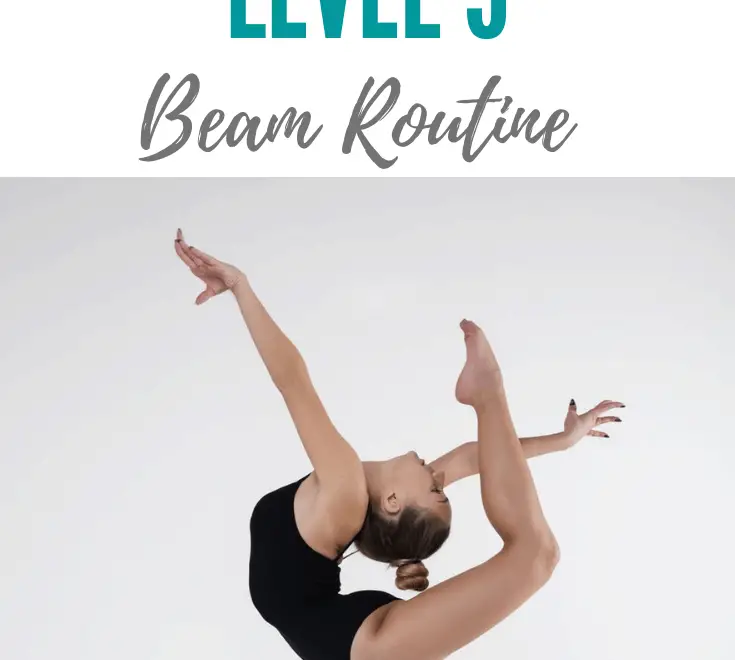This post has been updated to reflect the 2021-2029 compulsory routine changes.
Here comes the toughest compulsory level of all: Level 5. The routines have more skills in them, and the skills are more challenging. The skills in this level are great for progressing toward the optional levels. Some of these skills can be used for several levels to come. The Level 5 beam routine is hard to do well, but don’t worry! This guide will help to minimize deductions and get the best score for your Level 5 beam routine.
Introduction to Level 5 Beam
In order to score well on Level 5 beam, there are three different areas to focus on.
- First, make sure the skills are performed with good form and technique.
- Next, check the specific element deductions for each skill to be sure it is performed according to specifications.
- Finally, assess the routine in general terms, in areas such as rhythm, artistry, dynamics, and text.
If all three of these areas are in good shape, the routine should get a good score!
Level 5 Beam Skills
The Level 5 beam routine consists of the following skills:
- Front support fish pose mount
- Back walkover OR
Backward roll to ¾ handstand OR
Flic-flac step-out OR
Flic-flac to two feet OR
Front walkover - 1/1 turn
- Split jump 150°, sissonne
- Scale (horizontal)
- Straight leg leap 150°, stretch jump
- Cartwheel, stretch jump
- Back tuck dismount
General Execution Deductions
General execution deductions are ones that can be taken on any major element (skill) in a compulsory routine. Here is a list of general execution deductions that could be taken during a beam routine:
- Foot form – 0.05
- Leg separation – Up to 0.20
- Body alignment/position/posture in major elements – Up to 0.20
- Bent arms or legs (max deduction at 90 bend) – Up to 0.30
- Balance errors – Up to 0.30 (each)
- Grasping beam to avoid a fall – 0.30
- Fall (on or off the apparatus) – 0.50
- Failure to mark the passe position in releve at turn completion – 0.05
- Failure to contract or extend when indicated – Up to 0.10
- Leg swing/kick not to horizontal or above when required – Up to 0.10
- Incorrect leg alignment in arabesque – Up to 0.10
- Failure to perform turns in high releve – Up to 0.10
- Uneven leg separation in leaps/jumps – Up to 0.20
- Failure to keep arms by ears during entrance/exit of slow acro elements – 0.05
- Failure to land with feet together on 2-foot landing of jumps – Up to 0.10
- Insufficient split – Up to 0.20
- Incomplete turns – Up to the value of the element (usually up to 0.40)
Technique Changes for the 2021-2029 Compulsory Cycle
There have been some changes made in this cycle of compulsory routines. Here are the changes you’ll see throughout all of the beam routines:
- No kicks into acro elements
- No straight leg entry into acro elements
- Two choices for acro entries: lunge entrance or mountain climber entrance
- Two choices for acro exits: lunge exit or step-in exit to straight stand
If you’ve coached prior to 2021, you’ll notice that these are different from past compulsory routines, but there are more options now to allow for flexibility in coaching techniques. Win-win for everyone!
Level 5 Beam Routine
Each skill in the compulsory routines also has a specific technique that gymnasts are expected to perform. There are specific element deductions for each skill which measure the gymnast’s ability to perform the skill as prescribed. Here’s a rundown of the specific deductions for each Level 5 beam skill.
Front Support Fish Pose Mount
The Level 5 beam routine begins with a front support fish pose mount.
A fish pose is a pose in which one leg is straight and the other is bent, with the knees together. The gymnast must show an extended body in the front support position, or an up to 0.10 deduction can be applied.
An up to 0.10 deduction can be taken if the transition from the mount to stand is not continuous. If the gymnast performs a knee scale as she transitions to standing, it is a flat 0.30 deduction. A knee scale is a pose in which the gymnast is on one knee and the back leg is lifted off the beam. Make sure to drop the leg straight down to the side of the beam to avoid this deduction!
Next, the gymnast will perform a standing pose and a passe pose before her first acro element.

The acro element is the gymnast’s choice: back walkover OR backward roll to ¾ handstand OR flic-flac step-out OR flic-flac to two feet OR front walkover. I love the flexibility allowed by giving the gymnast so many choices!
Here are the deductions for each.
Back Walkover (150°)
When performing the back walkover, the leg should lift continuously into the walkover. There is a deduction of up to 0.10 if the leg starts to lift, drops, and then continues the lift. This deduction is also applied if the leg lift begins after the gymnast has already started to arch backward into the walkover.
The hands should be placed next to each other, or a 0.10 deduction for incorrect hand placement can be applied. The legs should show at least a 150° split (up to 0.20).
Common general execution deductions for the back walkover include bent legs (up to 0.30), bent arms (up to 0.30), poor body position (up to 0.20), and failure to cover the arms with the ears (0.05).
The back walkover can finish in a lunge position, or a step down to straight stand.
Backward Roll to ¾ Handstand
The backward roll to handstand, or back extension roll, must achieve at least 3/4 handstand (up to 0.20). It is acceptable to perform a full handstand, but the ¾ handstand requirement allows for a bit of leeway. If there is a complete lack of open, and the gymnast performs a backward roll stepout, she will receive a 0.60 deduction for changing the element. This deduction is applied if the head stays in contact with the beam the entire time.
Common general deductions for the back extension roll include poor body position (usually arched – up to 0.20) and leg separation (up to 0.20).
The back extension roll can finish in a lunge position, or a step down to straight stand.
Flic-flac Step-out
There are no specific element deductions associated with the flic-flac stepout, or back handspring step-out.. Watch for bent legs (up to 0.30), bent arms (up to 0.30), leg separations (up to 0.20), and body position (up to 0.20). The gymnast will jump backward in a tight arch position, but then she should show a stretched position once she passes through vertical.
The flic-flac step-out can finish in a lunge position, or a step down to straight stand.
Flic-flac to Two Feet
Just like the flic-flac step-out, the flic-flac (back handspring) to two feet does not have any specific element deductions. Again, make sure to keep arms and legs straight, feet together throughout, and show good body position (tight arch to hollow) and good foot form.
Front Walkover (150°)
The front walkover can begin using a mountain climber entry or a lunge entry.
The hands should be together (0.10 for incorrect hand placement). The gymnast should show a 150° split (up to 0.20 deduction for insufficient split).
General deductions also apply to the front walkover. Work on straight legs, straight arms, good foot form, and proper head alignment.
The gymnast should end by stepping into a straight stand with the feet closed.
After her acro skill, the gymnast will go into a series of poses before her full turn.
Full Turn
The gymnast should maintain the free leg in forward passe throughout the full turn (0.10). If she performs a heel-snap turn, the deduction is 0.30.
She must use one of the acceptable turn prep techniques from the Compulsory Handbook. Common general deductions during the full turn include poor body posture (up to 0.20), lack of releve, and incomplete turn (up to 0.40).
Watch for good posture and high releve as the gymnast steps into the lock stand.

Split Jump (150°), Sissonne
The split jump should take off and land with both feet at the same time. If the feet do not close on landing, there is an up to 0.10 deduction. If the feet do not land simultaneously, the deduction is an additional 0.10.
The gymnast should demonstrate good height, posture, form, and even leg separation. These areas can generate big deductions if they are compromised while trying to attain the 150° split.
The split jump should connect directly into the sissonne (0.05 for a broken connection).
The sissonne should be performed with a “tilted split line”, in which the back leg is higher than the front leg. The front leg should lift to at least 45° (up to 0.10), and the back leg should lift to at least horizontal (up to 0.10).
The jump should move forward and upward. Just as in the other leaps and jumps, there is an up to 0.20 deduction for insufficient height. There is no specific deduction for lack of forward movement, but that could be considered as a text error. The sissonne is expected to finish in an arabesque position, with a 0.05 deduction for failure to pause in the arabesque.
1/2 Squat Turn
This turn is not a major element, so only general deductions will apply. It’s common to see the gymnast forget to step in front after the sissonne. If she closes the back foot behind her, she will be on the wrong leg during the squat turn, and she will receive a deduction for reversing the squat turn.
Scale
The free leg should be above horizontal in the scale (up to 0.20), and the scale should be held one second (up to 0.10).
The gymnast may lean slightly forward into the scale, but an excessive forward lean could incur a body posture deduction. The gymnast should step directly into the leap after she completes the scale.
Straight Leg Leap (150°), Stretch Jump
After the scale, the gymnast does not tap her toe onto the beam, but she should step straight into her leap. The leap in the Level 5 beam routine is a straight leg leap, so if the gymnast performs a stag leap, or bends her front leg, she will receive an up to 0.10 deduction.
General execution deductions are the main focus during the leap: height (up to 0.20), posture (up to 0.20), and even split (up to 0.10). The required split angle is 150°, and the gymnast can receive an up to 0.20 deduction if the split does not meet the requirement. It’s usually best to focus on height and posture, though. Often those qualities are sacrificed for a larger split, and the deductions are more severe in that scenario.
The stretch jump, or straight jump, has a deduction of 0.10 if the gymnast does not land on both feet at the same time. Just like the leap, the focus should be on height and posture. The straight jump seems like such an easy skill, but you’d be surprised how often I see gymnasts who don’t get high enough off the beam to even get their toes pointed!
The leap and jump should be connected, but don’t worry if the connection is broken. There are no rhythm deductions during this dance series, and the deduction for a completely broken series is only 0.05.
Cartwheel, Stretch Jump
The cartwheel can be performed with either a mountain climber entry or a lunge entry. The gymnast should keep the arms over the ears in and out of the cartwheel (0.05 each time).
The hands should be placed on the beam one at a time (0.10 deduction for simultaneous hand placement). If the cartwheel does not pass through vertical, it is a deduction of up to 0.30.
The second foot should close behind the first foot at the completion of the cartwheel. If the second foot closes in front, it is a 0.20 deduction. The cartwheel should connect directly to the stretch jump (0.05 for broken connection).
The deductions on this stretch jump are the same as the one after the leap.

Back Salto Dismount
The gymnast should move through her final series of poses with good rhythm prior to the dismount. If the gymnast is in the wrong spot on the beam and needs to take steps to get into the right place, deductions are applied for additional steps.
Specific deductions include up to 0.30 for insufficient height and hip lift, up to 0.20 for insufficient tuck shape, and up to 0.20 for posture and control on the landing. Additionally, look for foot form, leg separations, and landing errors on the dismount.
General Routine Deductions
The final component of a great beam routine is general categories. At the end of a routine, judges will evaluate the routine as a whole in several different areas. These areas include artistry, rhythm, dynamics, text, sureness, releve, and posture. You can read more about these general deductions in this post.
Final Thoughts
The Level 5 beam routine is tough to do well, but it is so lovely when it is performed nicely! Remember the big 3: general form and execution, specific element technique, and general routine categories, and that routine will be flowing in no time!
Further Reading
How to Perform the Best Level 3 Beam Routine
How to Perform the Best Level 4 Beam Routine
General Categories for Exemplary Compulsories
The Best Gymnastics Beams for Home
The Best Gifts for Gymnasts (and Coaches!)
References
USA Gymnastics J.O. Compulsory Handbook, 2021-2029.

face mask says:
that’s a reasoned insight you have there!
Marvel Thede says:
Success thought u have shared.